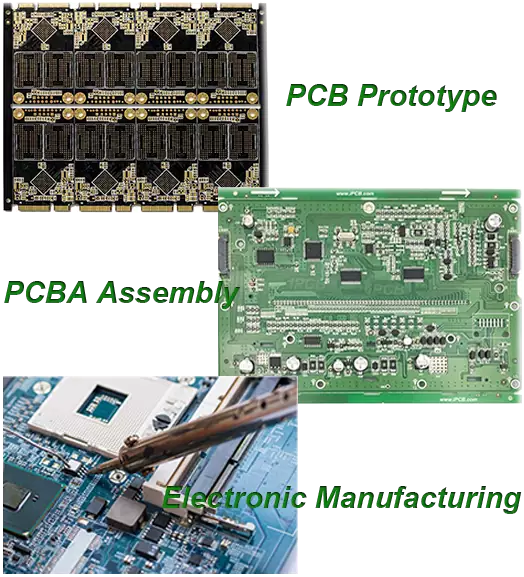The customer has a requirement to specify that the dielectric constant of FR4 must be 4.5. PCB board suppliers cannot guarantee such precise DK values for FR4. Why is the dielectric constant (DK) value of FR4 usually between 4.2-4.8?
Adding woven glass to PCB materials can increase the structural strength of the material. This helps to increase the mechanical stability of the circuit board material. The glass weaving effect may have a negative impact on the electrical performance of high-speed or high-frequency circuits processed on these circuit boards.
Depending on the specific resin system of the fiberglass circuit board, the dielectric constant (Dk) of this material actually varies in a very small periodic manner with position. These small regions with different Dk values may be caused by the unique physical weaving structure of glass fibers, where glass fiber fabrics are woven from glass fiber bundles, and there are also small open areas between the glass bundles. Among them, the Dk of glass fiber bundles is usually about 6, while the Dk of laminates in the open areas between bundles is much lower than that of glass fiber bundles, usually around 3. Due to the high dependence of the impedance of high-speed/high-frequency transmission lines on Dk, the variation of Dk value has always been a problem for circuit design engineers when using woven glass circuit boards.
The semi cured PCB and copper-clad laminate are composed of a mixture of epoxy resin and fiberglass cloth as the medium.
There are many types of glass cloth, each with different thicknesses and sizes. Some grid shaped fiberglass cloth windows are very large, while others are very small and almost non-existent.
The specific effects of fiberglass effect are on impedance, delay, and loss.
It should be noted that the glass fiber effect has the greatest impact on high-speed long lines, and low-speed systems or very short lines may not be considered.
For example, a double-sided copper-clad circuit board with top and bottom (signal transmission and microstrip ground plane) has a dielectric constant DK of 3.0 in the Z-axis (thickness) direction at 10 GHz. Usually at higher frequencies, such as millimeter wave frequencies (30GHz and above), changes in DK can affect the performance of materials.
For example, a quarter wavelength of a signal propagating through a circuit at 77GHz is approximately 0.024 inches, which means an eighth wavelength is approximately 0.012 inches. In theory, at wavelengths greater than a quarter of the frequency of interest, when electromagnetic (EM) waves encounter any type of DK variation on their propagation medium, the propagation of the electromagnetic wave will be disrupted and resonance may occur.
Practical experience has shown that even anomalies as small as one eighth of a wavelength can cause propagation problems of electromagnetic waves. Circuit boards with one eighth wavelength or higher frequency in glass or glass bundles may experience irregular performance due to the distribution of glass bundles (and corresponding changes in Dk). Given the types of glass that can be used to enhance different circuit boards, it is not uncommon for several types of glass to have gaps of one eighth wavelength or greater at 77GHz (0.012 inches).
The meaning is that the wavelength of millimeter waves is small, and when their size is comparable to the "gap" of FR4 glass fiber, the fluctuation of their DK changes greatly. This is one of the reasons why FR4 is not suitable for millimeter wave circuits.

fr4 pcb
Regarding countermeasures, the main ones are material selection, design avoidance, and production avoidance.
Material countermeasures
1. Use fiberglass cloth with small windows. That is to say, flat glass cloth, open fiber cloth, etc. Avoid the existence of effective dielectric constant fluctuations at the empty window of glass fiber cloth from the source. For example: 1067/1078/2116, etc.
2. Use multiple Prepreg overlays to reduce the probability of window exposure. The method is feasible, unless the medium is thick and requires multiple Prepreg stacks, my personal opinion is not as good as the first method. Firstly, it is due to cost, and secondly, when Prepreg is manufactured with more than three sheets, it is prone to slipping.
3. Use low dielectric constant glass fiber cloth to reduce the dielectric constant difference between glass fiber and epoxy resin, and to reduce the effective dielectric constant difference between the inside and outside of the window. Note: Low dielectric constant glass fiber cloth is usually only equipped with ultra-low loss sheets. That is to say, high-speed sheet metal has a high cost.
Design Attention
1. Important signals can be routed through lines with certain angles, such as 3°, 7°, 11°, etc., which basically do not increase the cost, but the layout is more difficult to do. I think all the layout buddies have already put this grudge on the notebook.
2. The layout of important signal rotation angles increases the difficulty of design. The little trick is to rotate the chip as a whole after FANOUT.
3. After normal design, rotate the board by 7° during assembly. This is equivalent to a sneaky operation with a full board of 7° wiring.
Production strategy
Normal design requires PCB manufacturers to rotate materials during production. We use core boards cut from large materials, which are square in shape. Rotating cutting will inevitably reduce the utilization rate of PCB boards, and Prepreg also needs to use larger ones. It will increase the cost of PCB manufacturing.